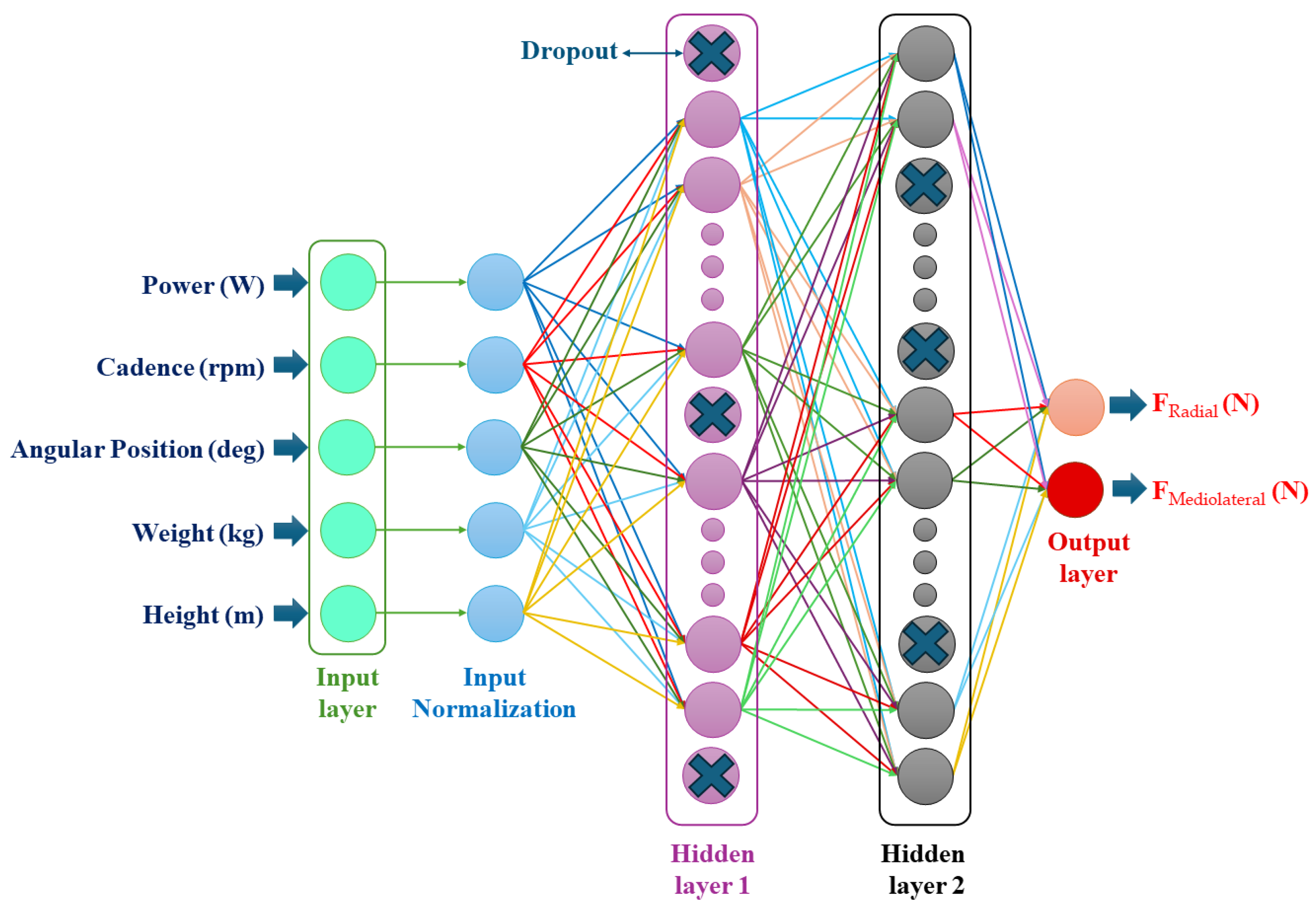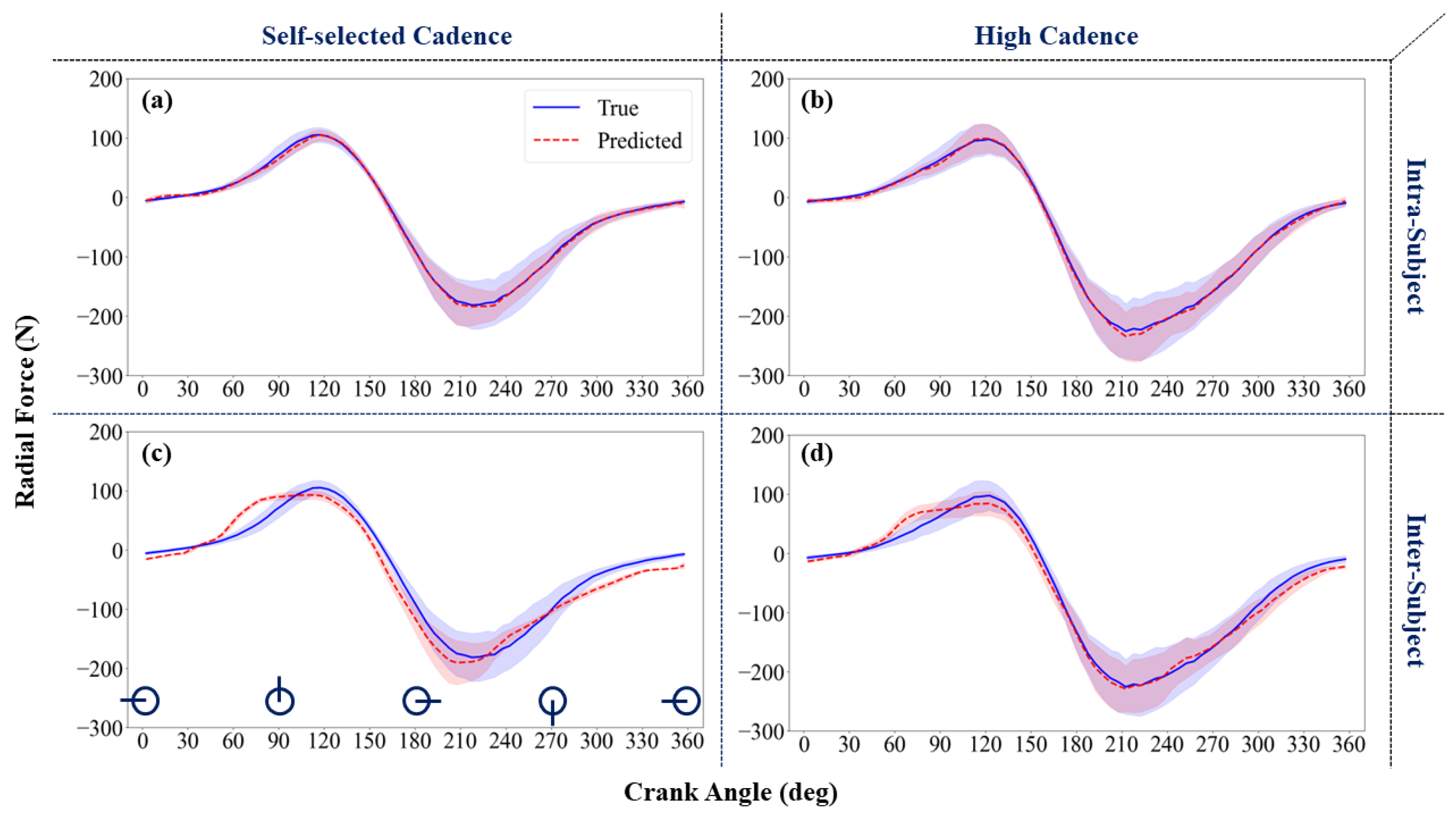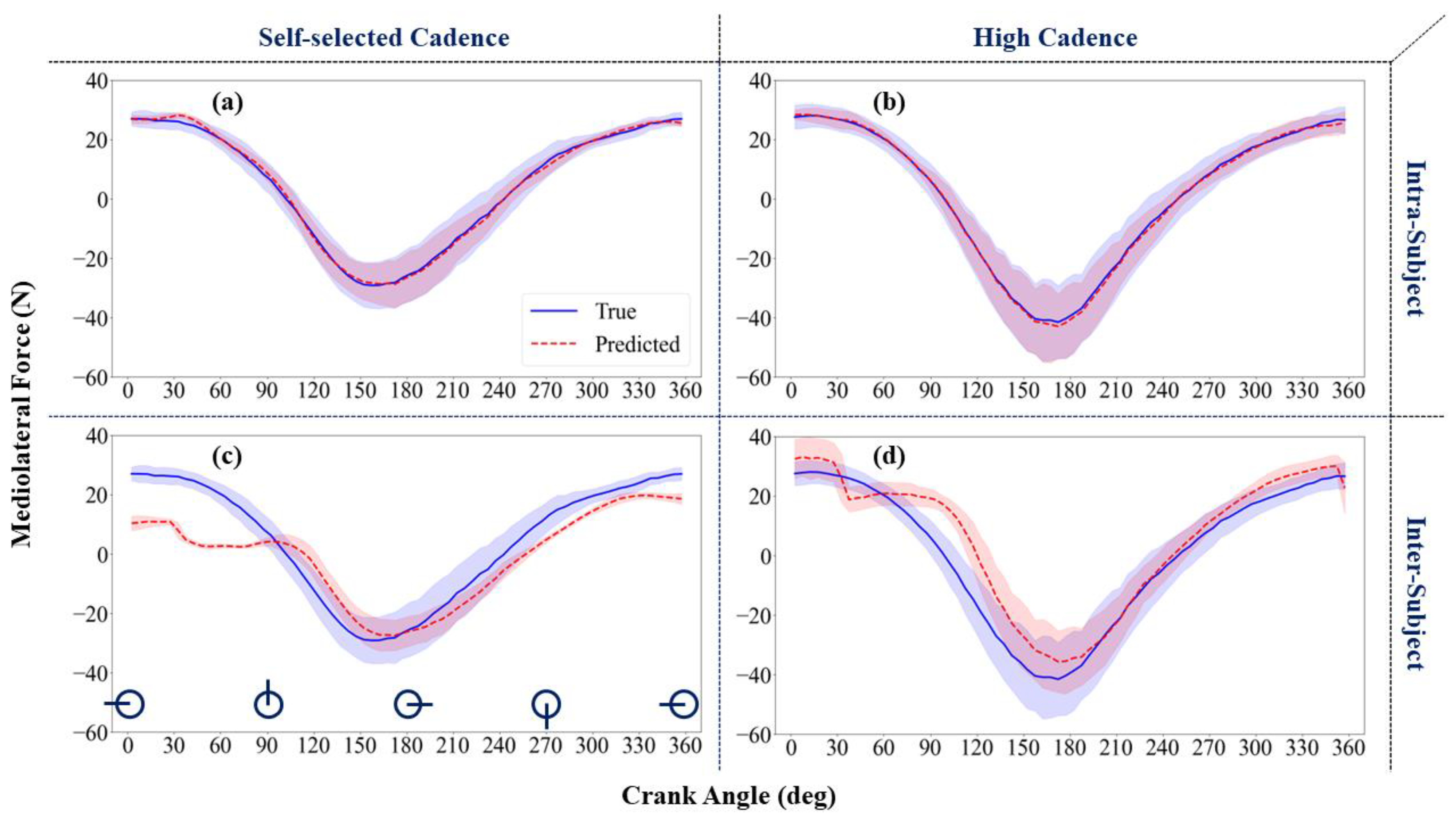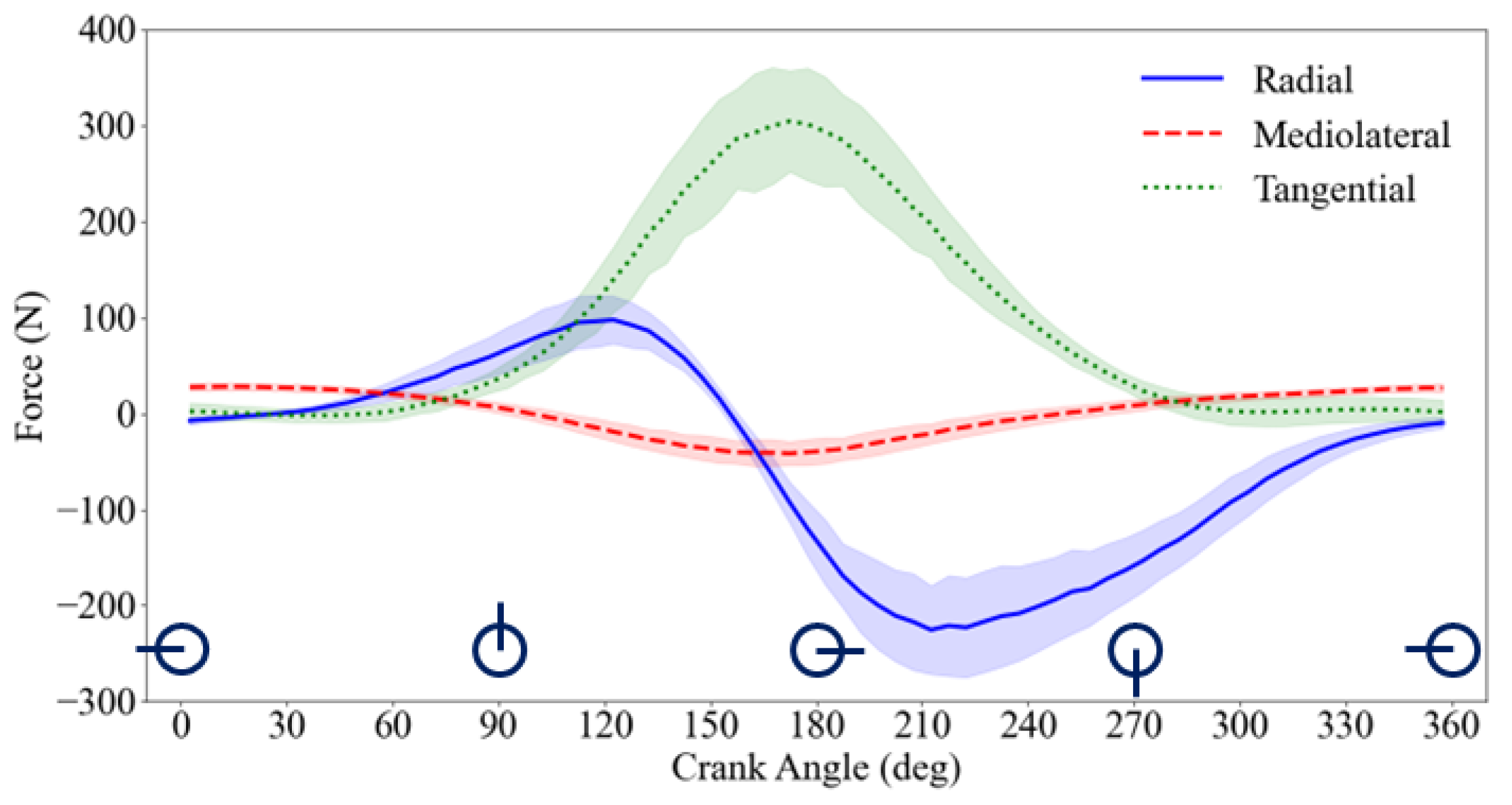Submitted:
06 August 2024
Posted:
07 August 2024
You are already at the latest version
Abstract
Keywords:
1. Introduction
2. Methodology
2.1. Data Collection
2.2. Data Preprocessing
2.3. ML Development
2.4. Performance Evaluation
3. Results
3.1. Radial Force
3.2. Mediolateral Force
4. Discussion
5. Conclusions
Author Contributions
Funding
Institutional Review Board Statement
Informed Consent Statement
Data Availability Statement
Conflicts of Interest
References
- B. Fonda and N. Sarabon, “Biomechanics of Cycling,” Sport Science Review, vol. 19, no. 1–2, Jan. 2012. [CrossRef]
- “FEATURE HEALTH BENEFITS OF CYCLING.” [Online]. Available: www.ubcmj.com.
- Y. Okita and T. Nakamura, “Effects of bicycle geometry and riding position on the potential of residual limb muscles to pedaling with a transfemoral prosthesis: a computer simulation study”. [CrossRef]
- F. Onasch and W. Herzog, “Active control of static pedal force direction decreases maximum isometric force output,” J Biomech, vol. 163, Jan. 2024. [CrossRef]
- J. Lozinski, S. H. Heidary, S. C. E. Brandon, and A. Komeili, “An Adaptive Pedaling Assistive Device for Asymmetric Torque Assistant in Cycling,” Sensors, vol. 23, no. 5, Mar. 2023. [CrossRef]
- H. Seratiuk Flores, W. L. Yeoh, P. Y. Loh, K. Morinaga, and S. Muraki, “Biomechanical Analysis of Recreational Cycling with Unilateral Transtibial Prostheses,” Prosthesis, vol. 5, no. 3, pp. 733–751, Sep. 2023. [CrossRef]
- H. Yum, H. Kim, T. Lee, M. S. Park, and S. Y. Lee, “Cycling kinematics in healthy adults for musculoskeletal rehabilitation guidance,” BMC Musculoskelet Disord, vol. 22, no. 1, Dec. 2021. [CrossRef]
- S. M. Parry et al., “Early rehabilitation in critical care (eRiCC): functional electrical stimulation with cycling protocol for a randomised controlled trial”, doi: 10.1136/bmjopen-2012.
- C. K. Tang et al., “Effects of Different Pedaling Positions on Muscle Usage and Energy Expenditure in Amateur Cyclists,” Int J Environ Res Public Health, vol. 19, no. 19, Oct. 2022. [CrossRef]
- J. P. Carmichael, E. W. Staton, P. J. Blatchford, and J. Stevens-Lapsley, “EPIDEMIOLOGY OF NECK INJURIES ACCOMPANYING SPORT CONCUSSIONS IN YOUTH OVER A 13-YEAR PERIOD IN A COMMUNITY-BASED HEALTHCARE SYSTEM,” Int J Sports Phys Ther, vol. 14, no. 3, pp. 334–344, 2019. [CrossRef]
- R. Bini and P. Hume, “Reproducibility of lower limb motion and forces during stationary submaximal pedalling using wearable motion tracking sensors,” Sports Biomech, vol. 22, no. 8, pp. 1041–1062, Aug. 2023. [CrossRef]
- E. Martín-Sosa, V. Chaves, I. Alvarado, J. Mayo, and J. Ojeda, “Design and validation of a device attached to a conventional bicycle to measure the three-dimensional forces applied to a pedal,” Sensors, vol. 21, no. 13, Jul. 2021. [CrossRef]
- B. E. Sibson, J. J. Banks, A. Yawar, A. K. Yegian, D. E. Anderson, and D. E. Lieberman, “Using inertial measurement units to estimate spine joint kinematics and kinetics during walking and running,” Sci Rep, vol. 14, no. 1, Dec. 2024. [CrossRef]
- R. R. Bini, P. Hume, J. Croft, and A. Kilding, “Pedal force effectiveness in Cycling: a review of constraints and training effects,” 2013.
- S. M. Rodger, D. J. Plews, J. Mcquillan, and M. W. Driller, “Evaluation of the Cyclus ergometer and the Stages power meter against the SRM crankset for measurement of power output in cycling,” 2016.
- N. A. Turpin and B. Watier, “Cycling biomechanics and its relationship to performance,” Jun. 01, 2020, MDPI AG. [CrossRef]
- G. Chunfu, Study on the Sensor for the Pedal Push Force of Bicycle. I E E E, 2009.
- E. Martín-Sosa, V. Chaves, E. Soler-Vizán, J. Mayo, and J. Ojeda, “Methodology to Analyse Three-Dimensional Asymmetries in the Forces Applied to the Pedals in Cycling,” Ann Biomed Eng, vol. 51, no. 3, pp. 618–631, Mar. 2023. [CrossRef]
- R. R. Bini, T. C. Jacques, C. H. Sperb, F. J. Lanferdini, and M. A. Vaz, “PEDAL FORCE ASYMMETRIES AND PERFORMANCE DURING A 20-KM CYCLING TIME TRIAL,” 2016.
- R. R. Neptune and W. Herzog, “The association between negative muscle work and pedaling rate,” 1999.
- R. R. Bini and F. Diefenthaeler, “Determining force and power in cycling: A review of methods and instruments for pedal force and crank torque measurements,” 2014. [Online]. Available: https://www.researchgate.net/publication/277077744.
- V. C. H. Chan, G. B. Ross, A. L. Clouthier, S. L. Fischer, and R. B. Graham, “The role of machine learning in the primary prevention of work-related musculoskeletal disorders: A scoping review,” Jan. 01, 2022, Elsevier Ltd. [CrossRef]
- M. Mundt, W. R. Johnson, W. Potthast, B. Markert, A. Mian, and J. Alderson, “A comparison of three neural network approaches for estimating joint angles and moments from inertial measurement units,” Sensors, vol. 21, no. 13, Jul. 2021. [CrossRef]
- M. S. Renani, C. A. Myers, R. Zandie, M. H. Mahoor, B. S. Davidson, and C. W. Clary, “Deep learning in gait parameter prediction for oa and tka patients wearing imu sensors,” Sensors (Switzerland), vol. 20, no. 19, pp. 1–21, Oct. 2020. [CrossRef]
- Boukhennoufa, Z. Altai, X. Zhai, V. Utti, K. D. McDonald-Maier, and B. X. W. Liew, “Predicting the Internal Knee Abduction Impulse During Walking Using Deep Learning,” Front Bioeng Biotechnol, vol. 10, May 2022. [CrossRef]
- T. P. Luu, H. B. Lim, K. H. Hoon, X. Qu, and K. H. Low, “Subject-specific gait parameters prediction for robotic gait rehabilitation via generalized regression neural network,” in 2011 IEEE International Conference on Robotics and Biomimetics, ROBIO 2011, 2011, pp. 914–919. [CrossRef]
- M. Sharifi Renani, A. M. Eustace, C. A. Myers, and C. W. Clary, “The use of synthetic IMU signals in the training of deep learning models significantly improves the accuracy of joint kinematic predictions,” Sensors, vol. 21, no. 17, Sep. 2021. [CrossRef]
- R. Ahmadi, M. Mohseni, and N. Arjmand, “An Artificial Neural Network to Predict Whole-Body 3D Posture During Dynamic Load-Reaching Activities”. [CrossRef]
- N. Amrani El Yaakoubi, C. McDonald, and O. Lennon, “Prediction of Gait Kinematics and Kinetics: A Systematic Review of EMG and EEG Signal Use and Their Contribution to Prediction Accuracy,” Oct. 01, 2023, Multidisciplinary Digital Publishing Institute (MDPI). [CrossRef]
- C. A. A. Izhar, Z. Hussain, M. I. F. Maruzuki, M. S. Sulaiman, and A. A. A. Rahim, “Gait cycle prediction model based on gait kinematic using machine learning technique for assistive rehabilitation device,” IAES International Journal of Artificial Intelligence, vol. 10, no. 3, pp. 752–763, Sep. 2021. [CrossRef]
- S. Galasso, R. Baptista, M. Molinara, S. Pizzocaro, R. S. Calabrò, and A. M. De Nunzio, “Predicting physical activity levels from kinematic gait data using machine learning techniques,” Eng Appl Artif Intell, vol. 123, Aug. 2023. [CrossRef]
- T. Yeung, A. Cantamessa, A. W. Kempa-Liehr, T. Besier, and J. Choisne, “Personalized Machine Learning Approach to Estimating Knee Kinematics Using Only Shank-Mounted IMU,” IEEE Sens J, vol. 23, no. 11, pp. 12380–12387, Jun. 2023. [CrossRef]
- M. Błażkiewicz and A. Wit, “Artificial neural network simulation of lower limb joint angles in normal and impaired human gait,” Acta Bioeng Biomech, vol. 20, no. 3, pp. 43–49, 2018. [CrossRef]
- Parsaei, R. Ahmadi, S. J. Aboodarda, and A. Komeili, “Predict Knee Kinematics During Stationary Cycling via Machine Learning Regression Models.”.
- R. Ahmadi, A. Parsaei, and A. Komeili, “Predicting Hip Kinematics with CNN during Cycling Task.”.
- R. R. Bini, G. Serrancoli, P. R. P. Santiago, A. Pinto, and F. Moura, “Criterion validity of neural networks to assess lower limb motion during cycling,” J Sports Sci, vol. 41, no. 1, pp. 36–44, 2023. [CrossRef]
- B. Hollaus, J. C. Volmer, and T. Fleischmann, “Cadence Detection in Road Cycling Using Saddle Tube Motion and Machine Learning,” Sensors, vol. 22, no. 16, Aug. 2022. [CrossRef]
- H. Lim, B. Kim, and S. Park, “Prediction of lower limb kinetics and kinematics during walking by a single IMU on the lower back using machine learning,” Sensors (Switzerland), vol. 20, no. 1, Jan. 2020. [CrossRef]
- S. E. Oh, A. Choi, and J. H. Mun, “Prediction of ground reaction forces during gait based on kinematics and a neural network model,” J Biomech, vol. 46, no. 14, pp. 2372–2380, Sep. 2013. [CrossRef]
- Z. Ripic et al., “Prediction of gait kinetics using Markerless-driven musculoskeletal modeling,” J Biomech, vol. 157, Aug. 2023. [CrossRef]
- S. M. Moghadam, T. Yeung, and J. Choisne, “A comparison of machine learning models’ accuracy in predicting lower-limb joints’ kinematics, kinetics, and muscle forces from wearable sensors,” Sci Rep, vol. 13, no. 1, Dec. 2023. [CrossRef]
- D. J. Sanderson, “The influence of cadence and power output on the biomechanics of force application during steady-rate cycling in competitive and recreational cyclists,” J Sports Sci, vol. 9, no. 2, pp. 191–203, 1991. [CrossRef]
- S. A. Kautz, M. E. Feltner, E. F. Coyle, and A. M. Baylor, “The Pedaling Technique of Elite Endurance Cyclists: Changes With increasing Workload at Constant Cadence,” 1991.
- M. Rossato, R. R. Bini, F. P. Carpes, F. Diefenthaeler, and A. R. P. Moro, “Cadence and workload effects on pedaling technique of well-trained cyclists,” Int J Sports Med, vol. 29, no. 9, pp. 746–752, Sep. 2008. [CrossRef]
- T. Henke, “REAL-TIME FEEDBACK OF PEDAL FORCES FOR THE OPTIMIZATION OF PEDALING TECHNIQUE IN COMPETITIVE CYCLING.”.
- R. R. Bini, A. C. Tamborindeguy, and C. B. Mota, “Effects of saddle height, pedaling cadence, and workload on joint kinetics and kinematics during cycling,” J Sport Rehabil, vol. 19, no. 3, pp. 301–314, 2010. [CrossRef]
- “Title: Does changing the bike frame influence pedal force pattern in mountain bike cyclists? 3,” 2019. [Online]. Available: https://www.sciencedirect.com/science/article/pii/S0765159719300280.
- F. P. Carpes, C. B. Mota, and I. E. Faria, “On the bilateral asymmetry during running and cycling - A review considering leg preference,” Nov. 2010. [CrossRef]
- Lucia et al., “In professional road cyclists, low pedaling cadences are less efficient,” Med Sci Sports Exerc, vol. 36, no. 6, pp. 1048–1054, Jun. 2004. [CrossRef]
- D. Hendry et al., “An exploration of machine-learning estimation of ground reaction force from wearable sensor data,” Sensors (Switzerland), vol. 20, no. 3, Feb. 2020. [CrossRef]
- T. Yamaguchi, Y. Takahashi, and Y. Sasaki, “Prediction of Three-Directional Ground Reaction Forces during Walking Using a Shoe Sole Sensor System and Machine Learning,” Sensors (Basel), vol. 23, no. 21, Nov. 2023. [CrossRef]
- R. R. Bini and P. Hume, “A Comparison of Static and Dynamic Measures of Lower Limb Joint Angles in Cycling: Application to Bicycle Fitting,” Human Movement, vol. 17, no. 1, pp. 36–42, Mar. 2016. [CrossRef]
- T. Korff, L. M. Romer, I. Mayhew, and J. C. Martin, “Effect of pedaling technique on mechanical effectiveness and efficiency in cyclists,” Med Sci Sports Exerc, vol. 39, no. 6, pp. 991–995, Jun. 2007. [CrossRef]






| Parameters | Mean | SD | |
|---|---|---|---|
| Number of Participant, N = 15 | |||
| Weight (kg) | 73.2 | 6.9 | |
| Height (m) | 1.71 | 0.08 | |
| Crank Length (m) | 0.17 | ||
| Duration of Test (min) | Self-selected Cadence | 2 | |
| High Cadence | 2 | ||
| Power (W) | Self-selected Cadence | 96 | 9 |
| High Cadence | 214 | 17 | |
| Cadence (rpm) | Self-selected Cadence | 58 | 5 |
| High Cadence | 72 | 7 | |
| RMSE | nRMSE | ||||
|---|---|---|---|---|---|
| Examination |
Force Component |
Self-selected Cadence |
High Cadence |
Self-selected Cadence |
High Cadence |
| Intra-subject | Radial | 11.5 ± 1.2 | 10.4 ± 1.2 | 0.05 ± 0.01 | 0.04 ± 0.01* |
| Mediolateral | 3.6 ± 0.7 | 3.3 ± 0.7 | 0.14 ± 0.01 | 0.12 ± 0.03* | |
| Inter-subject | Radial | 39.2 ± 6.9 | 33.4 ± 6.8 | 0.20 ± 0.04 | 0.15 ± 0.02* |
| Mediolateral | 9.3 ± 2.0 | 9.9 ± 2.4 | 0.22 ± 0.04 | 0.26 ± 0.05* | |
Disclaimer/Publisher’s Note: The statements, opinions and data contained in all publications are solely those of the individual author(s) and contributor(s) and not of MDPI and/or the editor(s). MDPI and/or the editor(s) disclaim responsibility for any injury to people or property resulting from any ideas, methods, instructions or products referred to in the content. |
© 2024 by the authors. Licensee MDPI, Basel, Switzerland. This article is an open access article distributed under the terms and conditions of the Creative Commons Attribution (CC BY) license (http://creativecommons.org/licenses/by/4.0/).





